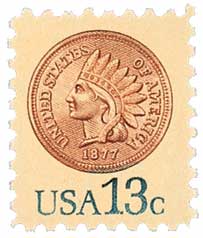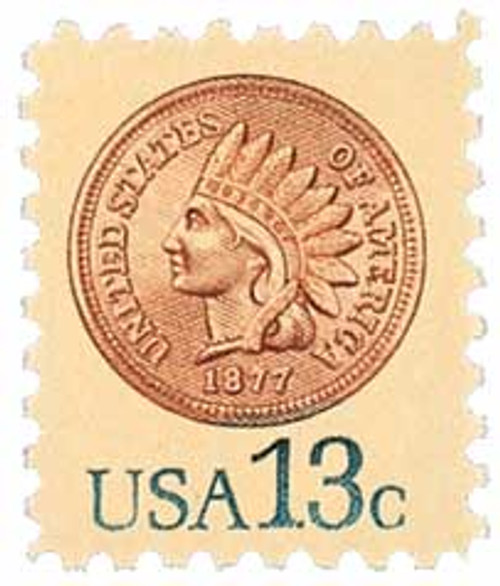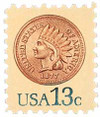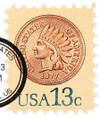
# 1734 - 1978 13c Indian Head Penny
America's Smallest Postage Stamp

On January 11, 1978, the USPS issued its smallest postage stamp, featuring the famed Indian Head Penny.
In the late 1970s, the USPS began looking into new ways to lower their production costs and increase their output. Eventually, they decided one possible way to achieve both of these goals was to make stamps smaller.
So in 1978, the USPS decided to test the idea. They chose as the design for the stamp the 1877 Indian Head Penny. The penny itself measured .75 inches, while the new midget stamp would be .54 x .66 inches. This smaller size meant a pane of stamps could hold 150 stamps, rather than the standard 100.
The experimental stamp was issued on January 11, 1978, in Kansas City, Missouri. The stamp was only available for use in five cities: Hartford, Connecticut; Richmond, Virginia; Portland, Oregon; Memphis, Tennessee; and Kansas City, Missouri. The USPS wanted to test the smaller stamp's popularity on a smaller scale before rolling out its usage nationwide.
In the end, postal customers in these test cities were unimpressed with the stamp's smaller size. They said it was too small to handle and could easily be lost.
America's Smallest Postage Stamp

On January 11, 1978, the USPS issued its smallest postage stamp, featuring the famed Indian Head Penny.
In the late 1970s, the USPS began looking into new ways to lower their production costs and increase their output. Eventually, they decided one possible way to achieve both of these goals was to make stamps smaller.
So in 1978, the USPS decided to test the idea. They chose as the design for the stamp the 1877 Indian Head Penny. The penny itself measured .75 inches, while the new midget stamp would be .54 x .66 inches. This smaller size meant a pane of stamps could hold 150 stamps, rather than the standard 100.
The experimental stamp was issued on January 11, 1978, in Kansas City, Missouri. The stamp was only available for use in five cities: Hartford, Connecticut; Richmond, Virginia; Portland, Oregon; Memphis, Tennessee; and Kansas City, Missouri. The USPS wanted to test the smaller stamp's popularity on a smaller scale before rolling out its usage nationwide.
In the end, postal customers in these test cities were unimpressed with the stamp's smaller size. They said it was too small to handle and could easily be lost.







